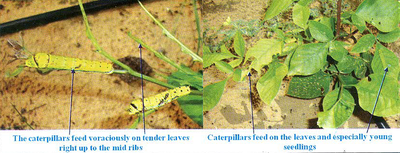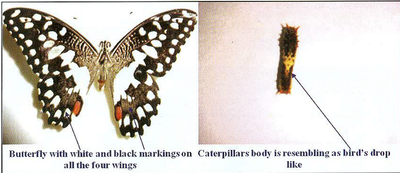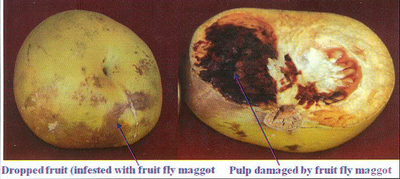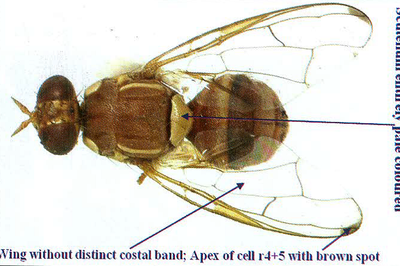Insect Pest of Bael in Hot Arid Region
Insect Pest of Bael in Hot Arid Region
Lemon butter fly (Papilio demoleus)
- This pest is widely distributed in Bangladesh, Sri Lanka, India and Pakistan. It is distributed all over India. It can feed and breed on all varieties of cultivated or wild citrus and various other species of family Rutaceae.
Host Range
- These are most destructive pests of citrus seedlings. Besides citrus, it also attacks bael, ber, wood apple, curry leaf etc.
Nature of Damage
- The caterpillars feed on the leaves and especially young seedlings and trees are seriously affected.
- Complete defoliation occurs in severe attack.

- Freshly hatched caterpillars are dark brown and soon develop irregular white markings on their body resembling, bird’s drop.
- The caterpillars feed voraciously on tender leaves right up to the mid ribs and defoliate the entire seedlings or the tree leaving behind the only midribs.
- It is present throughout the year.
Description
- This is a big beautiful butterfly with yellow and black markings on all the four wings, having wing expanse of about 50-60 mm.
- Its hind wings have a brick red oval patch near the anal margin and there is no tail like extension behind.

- Yellowish white, round, smooth eggs are laid singly on tender leaves and shoots.
- On disturbance the caterpillar everts out two orange coloured osmeteria with a characteristic smell.
- Full grown caterpillar is stout and about 40 mm in length.
Bael fruit fly (Bactrocera zonata)
- This species is widespread in south Asia from Pakistan, India and Sri Lanka to Southeast Asian countries such as Thailand, Laos, Vietnam and Indonesia.
Host Range
- The main hosts of fruit fly are guava, mango and peach. Secondary hosts include bael, apricot and citrus. B. zonata has been recorded on over 50 cultivated and wild plant species.
Nature of Damage
- Attacked fruits usually show signs of oviposition punctures.
- Fruits with a high sugar content, such as peaches, exude a sugary liquid, which usually solidifies adjacent to the oviposition site.

Description
- Wing without distinct costal band; apex of cell r4+5 with brown spot.
- Thorax and abdomen pale orange.
- Scutellum entirely pale coloured, except sometimes for a narrow black line across the base.
- Wing vein sc abruptly bent forward at nearly 90°, weakened beyond this bend and ending at subcostal break; vein R1 with dorsal setulae.

Source: Insect Pest of Arid Fruit Crops
Last Modified : 3/1/2020
© C–DAC.All content appearing on the vikaspedia portal is through collaborative effort of vikaspedia and its partners.We encourage you to use and share the content in a respectful and fair manner. Please leave all source links intact and adhere to applicable copyright and intellectual property guidelines and laws.
RELATED ITEMS
